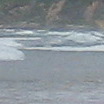Forebody Simulator Design Problem
Optimal design techniques have been applied to a variety of problems ranging from designing cars with improved fuel efficiency (via drag reduction and weight minimization) to designing the shape of an artificial heart valve to reduce its damage to the blood.
Traditionally, approximate solutions of these problems are found by "cut and try" methods, combining a designer's engineering experience with repeated experimental testing. Current methods take advantage of computational advances to compute the optimal design directly. Application of the sensitivity equation method is studied in this work.
The test problem below is motivated by the free-jet test facility at the Arnold Engineering Development Center (AEDC). This facility is used to test commercial and military jet engines under air flow conditions they would receive in flight. This facility consists of:- A supersonic wind tunnel to house the engine.
- A nozzle to direct the flow, simulating flight at different angles of attack and yaw.
- A forebody simulator (FBS) to produce an engine inlet profile, replacing the forward fuselage (forebody) of the aircraft due to size constraints.
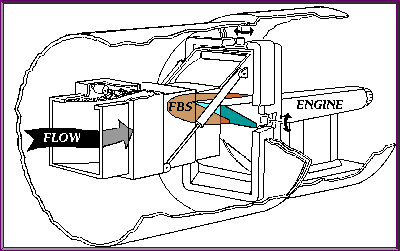
The design of the forebody simulator is an important step in any test, since it shapes the flow profile to the engine inlet. In this study, we consider a two dimensional analogue of this problem.
Modeling assumptions:
- 2D Euler equations
- compressible,
- inviscid,
- steady-state flow
- Design variables
- Inflow mach number
- Bezier parameters (describe the FBS shape)
The flow we want to match is produced by solving the Euler equations with a given original forebody profile. In the motivating application, this would be obtained from wind tunnel data or solving the Euler equations for a jet forebody at the desired attack and yaw angle.
We then seek a shortened forebody shape (half the length of the original forebody) which simulates the effect of the original forebody on the outflow.
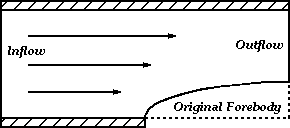
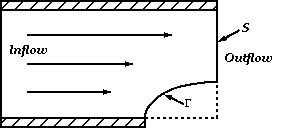
Since we have restricted ourselves to using a shortened forebody, we don't expect to match the outflow exactly. Therefore we create a measure of how close we are. This measure is the least squares error in the density, momentum and pressure at the outflow.
The sensitivity equation method was used to solve this problem.
The optimization was performed starting with the parameters:
- Inlet Mach Number, M = 2.0
- B1 = 0.10
- B2 = 0.15 (Bezier parameter values B1 and B2 used in describing the long forebody)
The method produced the "optimal" parameters:
- M = 2.020
- B1 = 0.294
- B2 = 0.156.
A comparison of the initial and final shapes, along with the data generated by the original forebody is presented below.
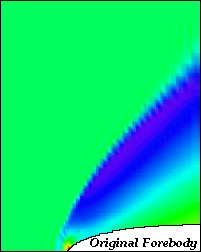
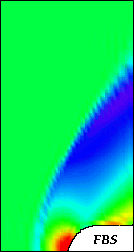
View either an mpeg movie or a quicktime movie of the iterations to convergence.
It was observed that the first Bezier parameter converges first producing a blunter forebody which forces the shock to emminate from in front of the forebody. The shock then slides up the outflow boundary to match the shock location of the long forebody.
The second Bezier parameter increases at first to help produce a blunt forebody, then later in the iteration, decreases to better match the flow closer to the forebody.
The iteration converged quickly due in part to the presence of the shock (investigated in related work).
For more details, please consult:
- Borggaard, J., Burns, J. Cliff, E. and Gunzburger, M., Sensitivity Calculations for a 2D, Inviscid, Supersonic Forebody Problem, in Identification and Control in Systems Governed by Partial Differential Equations, H.T. Banks, R.H. Fabiano and K. Ito editors, SIAM, Philadelphia, pages 14-25, (1993). (Also appeared as ICASE Report No. 93-13)
- Borggaard, J. and Burns, J., A Sensitivity Equation Approach to Shape Optimization in Fluid Flows, in Flow Control, M. Gunzburger editor, Springer-Verlag, pages 49-78 (1995). (Also appeared as ICASE Report No. 94-8)
- Borggaard, J., On the Presence of Shocks in Domain Optimization of Euler Flows, in Flow Control, M. Gunzburger editor, Springer-Verlag, pages 35-48 (1995).
- Algorithms for Flow Control and Optimization (with J. Burkardt, J. Burns, E. Cliff, M. Gunzburger, H. Kim, H. Lee, J. Peterson, A. Shenoy and X. Wu) in Optimal Design and Control, J. Borggaard, J. Burkardt, M. Gunzburger and J. Peterson editors, Birkhauser, pages 97-116 (1995).
- A PDE Sensitivity Equation Method for Optimal Aerodynamic Design (with J. Burns), Journal of Computational Physics, Vol. 136, pages 366-384, (1997).
This research was performed from 1992-1995 and was joint work with:
- John Burns, Gene Cliff and Max Gunzburger at Virginia Tech's Interdisciplinary Center for Applied Mathematics, and
- Karl Kneile and Don Todd at the Arnold Engineering Development Center.
Funding was provided by the Air Force Office of Scientific Research under grants F49620-92-J-0078 and F49620-93-1-0280.
Some of the multimedia on this page was generated as a project for Scientific Visual Analysis with Multimedia (ESM 5984, now ESM 4714) with John Burkardt.




